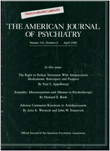Linguistic dimensions of affect and thought in somatization disorder
Abstract
DSM-III has established diagnostic criteria that separate somatization disorder from other overlapping symptom configurations. Nevertheless, information regarding the experience of somatization disorder is far from complete. Terms such as "masked depression" or "alexithymia" imply that a disturbance of affect is a central but guarded issue for at least some somatizing patients. Through content analysis of speech, the authors investigated the self-experience of somatization disorder in relation to affective disorder. Rather than defended depression, a distinctive characteristic found in the language of patients with somatization disorder reflects a confused, negative self-identity.
Access content
To read the fulltext, please use one of the options below to sign in or purchase access.- Personal login
- Institutional Login
- Sign in via OpenAthens
- Register for access
-
Please login/register if you wish to pair your device and check access availability.
Not a subscriber?
PsychiatryOnline subscription options offer access to the DSM-5 library, books, journals, CME, and patient resources. This all-in-one virtual library provides psychiatrists and mental health professionals with key resources for diagnosis, treatment, research, and professional development.
Need more help? PsychiatryOnline Customer Service may be reached by emailing [email protected] or by calling 800-368-5777 (in the U.S.) or 703-907-7322 (outside the U.S.).



